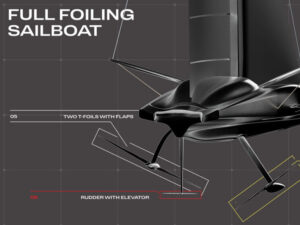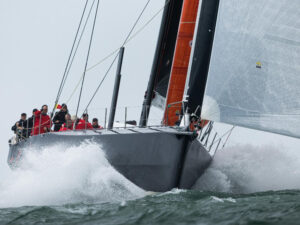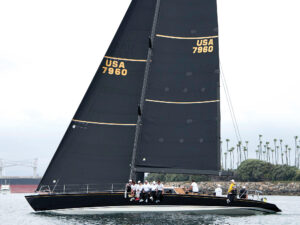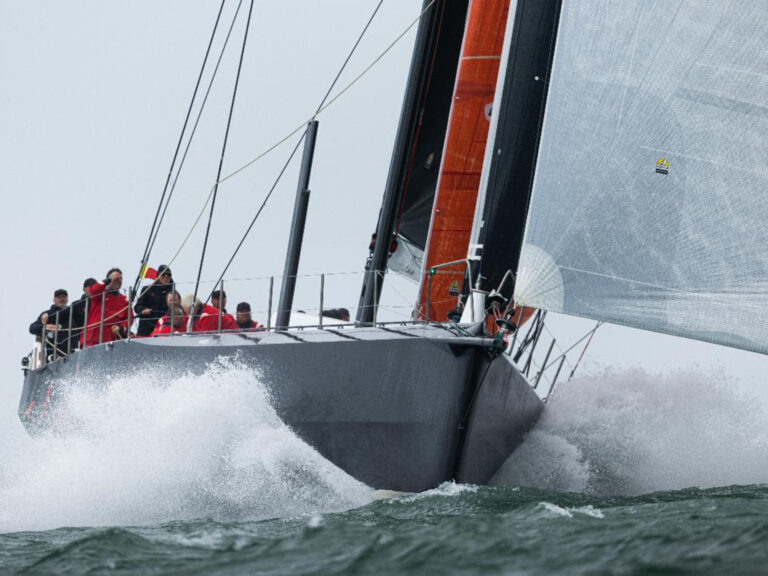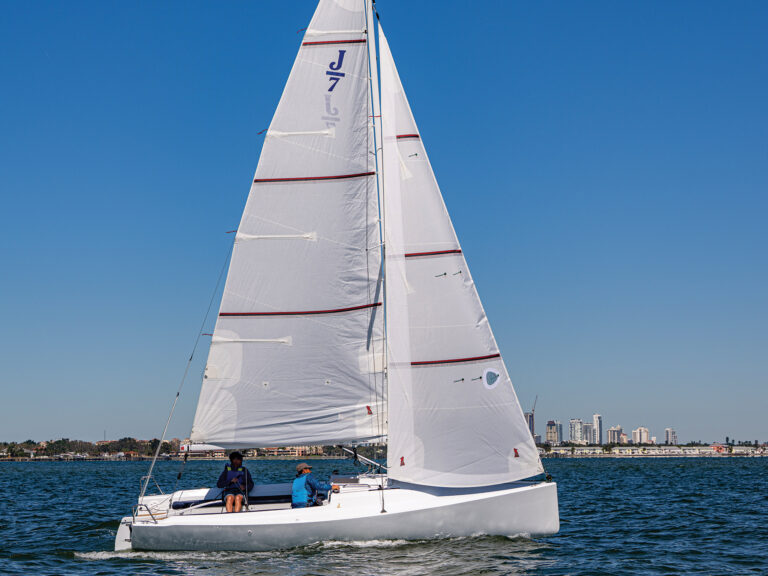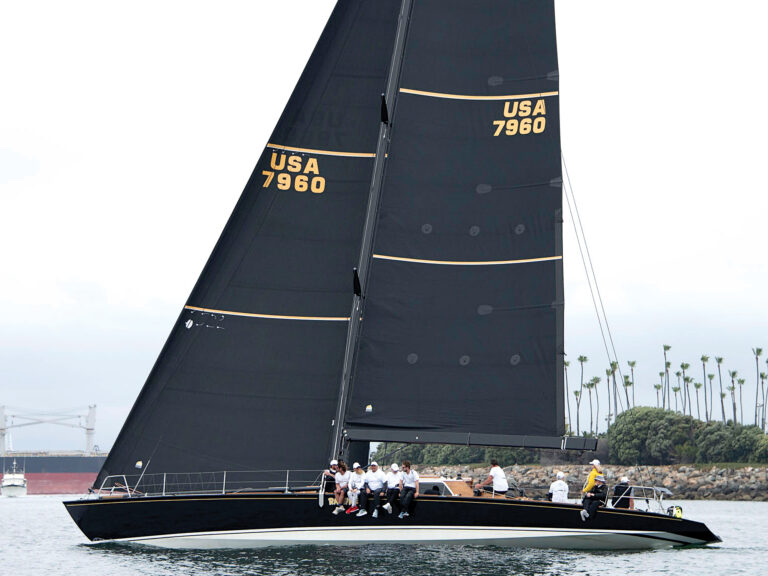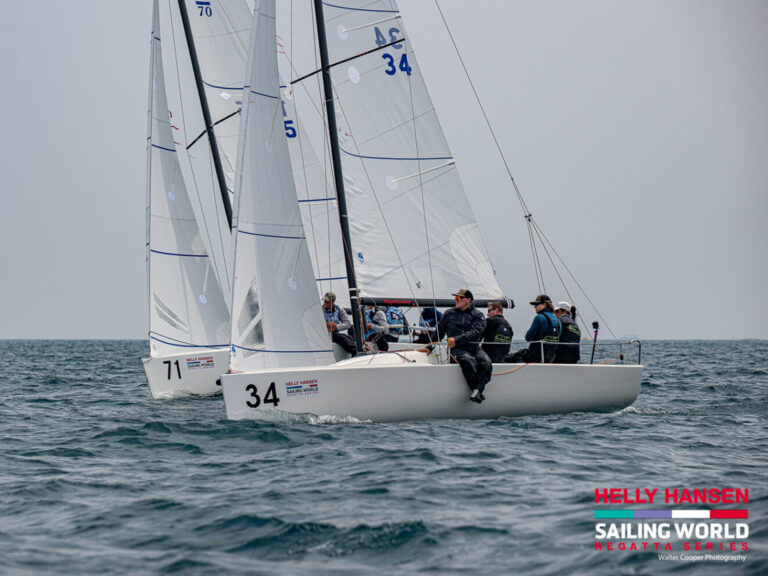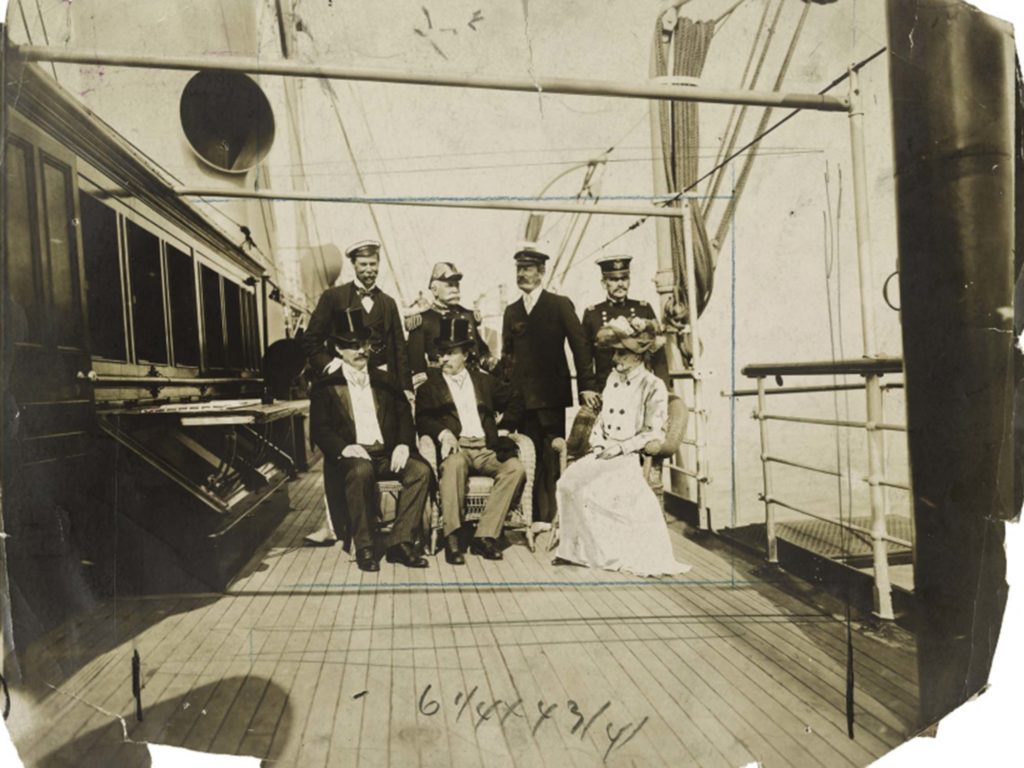
Winning the America’s Cup requires excellence in a number of areas, including management, financial resources, a leading design team, a fast boat, a top skipper and a smooth-operating crew. If any one of these vital areas is lacking, an America’s Cup effort is doomed. A successful campaign is managed by someone with cunning and integrity, who is pragmatic and calm during the heat of battle. Over the long history of the Cup, few individuals have excelled in this manner, and among them is Charles Oliver Iselin, who sailed in six winning defenses. Every one of his campaigns had unique and strange quirks that challenged one of the most dynamic managers in America’s Cup history.
Iselin’s final campaign was managing Reliance, the massive Herreshoff masterwork that easily defeated two potential defenders and Sir Thomas Lipton’s third challenge in 1903. Eight years earlier, Iselin had his integrity questioned by Windham Wyndham-Quin, the 4th Earl of Dunraven, who claimed he had cheated by secretly adding ballast to Defender in the middle of the night. Iselin had a good reputation and was outraged by the claims. After an exhaustive inquiry and hearings, Iselin was cleared of any wrongdoing. Following this potentially career-ending debacle, Iselin managed three more winning campaigns. In the process, he secured a legacy of excellence that deserves study and recognition.
Iselin was born with great wealth. His great-grandfather, Issac Iselin, emigrated to the United States in 1801 from Basel, Switzerland, and was a successful merchant, trading goods around the world. The Iselins became one of the wealthiest families in the United States at the time. Oliver Iselin grew up sailing at an early age, cutting his teeth on the Long Island Sound sandbaggers, which were raced by grizzled, aggressive professional sailors. The sandbaggers carried clouds of sail. The hulls were a scow shape and used centerboards to keep the wide-beamed boats on course. Crews shifted bags of sand to the windward side on every tack to give the boat stability. It was an arduous process that tested crews to their breaking point. The sandbaggers were unstable if the bags were not shifted promptly. Many a crew found themselves in the water after a capsize. The riskier the task, the better—that was the culture that Iselin learned to race.
In 1873, as a 19-year-old, he purchased a sandbagger named Mary Emma. Four years later, he was defeated in a race and acquired a new one named Dare Devil. He was earning a good reputation as a talented sailor and was elected as a member of the New York YC in 1877—at the age of 23. The club would benefit from his management prowess. In 1893, Iselin was named the managing owner of a new Herreshoff-designed and -built yacht named Vigilant. The America’s Cup had four defense candidates that year, including Jubilee, Pilgrim, Colonia (also a Herreshoff yacht) and Vigilant.
Iselin had a secret plan for Vigilant. The crews on Cup boats back then numbered about 40. Vigilant planned to race with a crew of 70. The idea was to place the crew on the windward rail to give the yacht extra stability. As one might imagine, the practice was controversial. Vigilant’s frame and topsides were made out of steel, while the hull below the waterline was made of a smooth bronze metal. Vigilant also sailed with more than 11,000 square feet of sail, which kept the crew busy.
Vigilant prevailed in the selection trials and faced Lord Dunraven’s Valkyrie II for the America’s Cup. The match was a best-of-five series. Vigilant easily won the first two races by wide margins of 10 minutes and 35 seconds, and five minutes and 48 seconds. The third race was close. Valkyrie II sailed to a two-minute lead at the end of two of the three legs. On the final leg, a reach, Valkyrie II ripped its spinnaker, and then ripped the replacement when it got tangled in the rigging while being hoisted. Vigilant was able to sail over the top of the disabled challenger and successfully defended the Cup by a 40-second margin. It was the closest race in America’s Cup history until that point in time.
There were good feelings around New York Harbor after the match, and Dunraven was encouraged by the close finish in the third race. After returning to Great Britain, Dunraven proposed another challenge, in 1897, which was accepted. Iselin went to work to build a new yacht for the defense as one of the owners and served as the team’s manager. Herreshoff experimented with some new composite materials. The deck of the new yacht, named Defender, was built of aluminum. Herreshoff and his design team did not know that aluminum and bronze, along with salt water, did not mix well. Defender was literally fizzling throughout the summer but easily earned its berth in the America’s Cup against its American rivals. The big question was whether the yacht would be fast enough to defeat Valkyrie III?
The match was big news in all the New York newspapers. Huge paying crowds turned out to watch the races on vessels of all sizes. Defender handily won the first race by seven minutes and 45 seconds. At the start of race two, there was a collision between the two yachts. Valkyrie III won the race on corrected time by the close margin of 47 seconds. After reviewing all the images and taking testimony from the crews on both boats, the race committee disqualified Valkyrie III.
The race committee and Iselin offered to resail the race, but Dunraven wanted no part of a second-chance race. He complained bitterly about the confused seas caused by the encroaching spectator boats, so the New York YC asked members to patrol the racecourse and push the armada of spectator boats away from the racing yachts. The effort was not successful. At the start of the final race, Dunraven had his yacht cross the line and withdraw from the race. Everyone was disappointed because people anticipated a close match based on Valkyrie II’s performance four years earlier. C. Sherman Hoyt, who defended the Cup in 1934 (Rainbow), was disgusted by the actions he witnessed: “I shall not forget the sight of Defender,” Hoyt wrote in his memoirs, “after sailing around the course alone, hoisting huge American yacht ensigns at [the] masthead and spreaders. To my youthful mind it appeared, and still does, bad taste after such an unsatisfactory series.”
The situation worsened two months later, when Dunraven wrote an article accusing the Americans of cheating. Iselin was outraged. He requested the New York YC set up a blue-ribbon panel to review the charges and the facts. Iselin believed the negative press was damaging his good reputation. A panel was appointed by the club’s commodore, Edward Marsh Brown, and every word of testimony was recorded. The committee published a 556-page book that contained the testimony of all the witnesses and the findings. In the end, Iselin was exonerated, and Dunraven was offered the opportunity to withdraw his charges. Dunraven ignored the request and never participated in the America’s Cup or any yachting again.
With his name cleared, however, Iselin signed on with J.P. Morgan to manage the next Cup defense in 1899 against Thomas Lipton. He commissioned Herreshoff to design and build a new yacht and recruited a rising star as skipper, Capt. Charlie Barr. As was his practice, Iselin sailed as a member of the crew and served as tactician. Although, because the term tactician was not used at that time, he was considered to be an “advisor.” When the new yacht, christened Columbia, was launched at the Herreshoff yard, its 19-foot draft was too deep for the site, and the vessel got stuck in the mud for nine hours. Once the boat was floating, the team got to work tuning Columbia.
In a race during the club’s Annual Cruise, Herreshoff experimented with a hollow steel mast with a telescoping topmast for Columbia. John Parkinson writes in his book, The History of the New York Yacht Club (1975): “The mast on Columbia collapsed on deck when she was leading Defender off Newport in a trial race, Mr. Iselin narrowly escaping injury.” Three formal trial races were raced in early September, with Columbia easily winning.
Iselin worked closely with the US government to provide patrol craft to keep the racecourse clear. It was a good thing because there were hundreds of boats out to watch Lipton’s Shamrock race against Columbia. Lipton arrived in New York like a breath of fresh air compared with the toxic atmosphere left behind by the Dunraven affair. Unfortunately, his first challenge was not strong. The match was a best-of-five series. The first race was a horizon job for Columbia, crossing the finish line 10 minutes and eight seconds ahead. In the second race, Shamrock’s topmast cracked and fell to the deck. Columbia sailed around the course alone to win the race. There was no talk of a resail, as had been proposed in previous Cups when one boat was unable to finish. The third race was slightly more competitive in a moderate-to-strong northerly breeze. Columbia won by six minutes and 34 seconds. And that was it. Lipton vowed he would challenge again.
Two years later, Lipton returned with a new Shamrock that was faster and better sailed. Unlike Dunraven, however, Lipton did not race aboard his yacht. He was content to watch and entertain on his motor vessel. Columbia and its skipper, Barr, returned to defend the Cup, but Iselin had moved away from managing and joined the New York YC’s America’s Cup Committee. Columbia faced two new defenders, a Herreshoff-designed and -built yacht named Constitution, and a scowlike yacht named Independence owned by Thomas Lawson.
The America’s Cup Committee watched Columbia and Constitution trade victories in a series of races on Long Island Sound and off Newport. After 18 races, the score was 9-9. Barr was more aggressive and fouled out of a few of the races. The big question for Iselin and other members of the committee was whether to select Constitution, which may have been slightly faster, or to select Columbia with the knowledge that Barr would be a reliable defender. In the final race, Barr was disqualified for a foul on the starting line. Even still, the committee decided Columbia was the better choice and selected Barr to defend the America’s Cup. Herreshoff was upset and declared he was retiring from the America’s Cup.
The new Shamrock II closed the gap and came closer to winning, although it still lost in three straight races. The margins were one minute and 20 seconds, three minutes and 35 seconds, and the final race saw Shamrock II cross the finish line two seconds ahead of Columbia but lose by 41 seconds on corrected time.
The New York YC was getting weary of funding defenses in rapid succession. Lipton, however, was ready to challenge again. A syndicate comprised of Cornelius Vanderbilt, William Rockefeller and P.A.B. Widener had the funding to repel Lipton’s third challenge. Their first recruit was to bring Iselin back as the team’s manager, and he went to work convincing Barr to skipper another defense. With Barr, money always talked, and a suitable arrangement was agreed upon. The final piece of the puzzle was getting Herreshoff out of retirement. Herreshoff sealed the deal when he pronounced, “I will design a boat that is so fast, Lipton will never come back.”
That was music to the ears of the syndicate. Funding by New York YC members was more than adequate for Herreshoff’s latest creation. The result was Reliance, a 143-foot-long behemoth with 16,160 square feet of sail area. Lipton’s Shamrock III was no match for Reliance. The Americans won the first two races by comfortable margins. In the third and final race, Shamrock III got lost in the fog and didn’t finish the race.
The 1903 America’s Cup would be the last for Iselin, but he had left his mark. He was a person of upstanding character, a diligent manager and one tough competitor. These attributes were learned early in his life and served him well over 16 years and six successful America’s Cup defense efforts. Iselin, who passed away in 1932, was inducted into the America’s Cup Hall of Fame in 1994.
This profile is an excerpt from Gary Jobson’s upcoming book, Characters of the America’s Cup, in which he writes about America’s Cup sailors from 1851 through present day.

